Stone, minerals and semiprecious of the world stone
Sulphide: Antimonite -->rus
 Diagnostic cart.
Diagnostic cart.
Antimonite are crystals of prismatic and needle-shaped type
Sb2 S3
Crystal structure rhombic
Hardness on the Mohs scale 2
Specific unit weight mass 4,6-4,7
Cleavage perfect absolute
Fracture, break uneven
Colors steel-grey
Colors in powder triturate black-grey
Glance (glitter, glare) metallic

Antimonite, stibnite (stibium antimonial ore). Glance (glitter, glare) metallic, opaque. Fracture, break step to uneven. Fragile. Cleavage perfect absolute. Be found mainly in low temperature hydrothermal deposits. Crystals (rhombic Crystal structure) of pole, needle. Aggregates usually radiant, rarer dense, grainy. Important ore of antimony. Places of distribution: Germany, Yugoslavia, Algeria, Mexico, Bolivia, China, Japan, CIS. A antimonial ochre (stibiconite) arises up at oxidization of sulfides of antimony.
Has a steel-grey color, opaque, with metallic off-gloss. Antimonite is presented prismatic and needle-shaped crystals, sometimes bent, with shading parallell to lengthening. Often crystals are grouped in fibred-radiant aggregates; usually confusingly-fibred or dense the masses. A mineral is soft, heavy, with perfect cleavage, parallel lengthening.
Diagnostic indication.
Crystals are flexible, but not elastic. Often covered iridescent tape, although in-bulk Antimonite sometimes transformed in red kermesite or other powdery minerals (antimonial ochres). It allows to distinguish Antimonite from a bismuthine. Single scales can be melted in flame of candle, that is another difference from a bismuthine which not melt fuse.
Origin provenance genesis.
Antimonite - mineral of hydatogenesis. It is associated with the minerals of silver, lead, mercury; can be deposited also from solutions of mineral springs.
Deposit minefield mine field occurrence subsoil.
Magnificent crystals, long to 50 sm, were found on the deposit (now already exhaust) of Ichinokava (Japan). Other deposits, known the beautiful crystals of antimonite - Felshebanya and Kapnik in Romania, many areas in the state of Californium (USA) and on Borneo. Developed in the industrial scale of bed in provinces Hunan and Guandun in China, where Antimonite be found jointly with a cinnabar. Found out other deposits of commercial-size in Peru, Bolivia, Mexico and France. In Italy beautiful crystals are obtained in Toskane, in Rosia (a province Siena) and Nikolette (province of Grosseto), and also in Sardinia, where this mineral is presented as dense the masses.
Use, practical application, deployment.
Antimonite matters very much as a source of receipt preparation of antimony. This element is used in different industries, including in the alloys of metals, and also in medicine.
In a translation Antimonite means "against monks". In one of the European monasteries at fattening of pigs used pounded in powder of Antimonite, and a pig is enough grew fat not bad. From the best motives a cook decided to add this powder to the supper of the colleagues on a monastery, that monks also were well-fed and not thin. On a morning all of monks died from poisoning, and stone got the modern name.
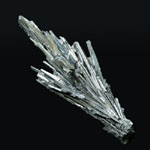

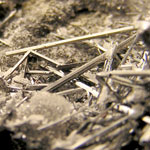
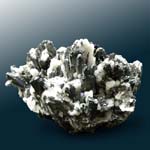
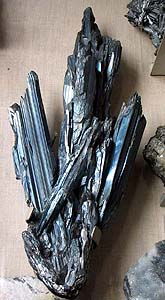
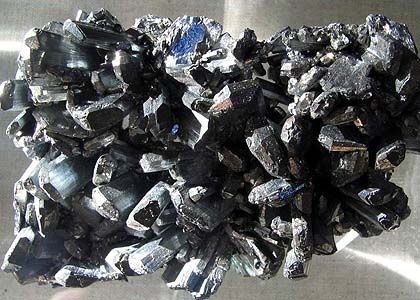
Antimonite. Sikoku of о., Japan. Brush of pinacoidal of prismatic crystals. Baya-sprie, Romania (EU). A photo: © A.A. Evseev.
Dangerous "hazardous cargo", signs #6.1 
Toxic non biological matters substances (toxin)
Risk of poisoning at inhalation, contact with a derma or swallowing. Make a danger for a water environment or sewage system
To use a mask for emergency abandonment of transport vehicle
White rhombus, number of Dangerous "hazardous cargo", signs, black skull and crossed cross-bones
Dangerous "hazardous cargo", signs #8 
Corrosive (caustic, pungent, acrid) substances matters
Risk of burns as a result of eating away of derma. Can stormily react between itself (components), with water and other matters. Matter, that spilled / scattered, can select a corrosive pair.
Make a danger for a water environment or sewage system
White overhead half of rhombus, black - lower, isometric, number of DOPOG, test tubes, hands
